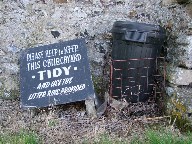| |
|
 |
|
I first came to Corton
parish church at the end of the long
summer of 2000. Over the previous
eighteen months, I had visited every
single church within a five mile stretch
of the Suffolk coast, except this one. I
had seen it often enough, its derelict
tower a powerful ghost towards the sea
from the A12, as that road thunders out
of Norfolk. A couple of Suffolk parishes
are further north; but Corton feels
like the end of the world. Here, on the
outermost tip of sprawling Lowestoft,
among the holiday camps and waste
disposal sites (why do they always put
them so close together?) there is a
feeling that we have stretched our sense
of Suffolkness to an extreme. This, of course, is
an illusion. Until 1974, the county
boundary was a few miles further north,
and the churches of Hopton, Belton,
Fritton, Burgh Castle and Bradwell, now a
suburb of Gorleston, were in Suffolk. Somehow, though, up
here, especially in winter, the colours
fade; the land and the sea are all too
often wreathed in frets, the wide open
vastness of Norfolk is but a step away,
and I felt no sense of belonging.
|
The main road out
of Lowestoft cuts across heathland, straight and
undulating, with the wild sea off to the east.
Suddenly, it narrows, and Corton is a surreal mix
of pretty flint cottages and high
fence-surrounded holiday camps, which I cycled
hurriedly past, and then out again, for the
church is beyond the village. St Bartholomew is haunting and
lonely; there are many ruined churches along this
coast, but this tower's gaping wounds, roughened
by the salt sea winds, seem infinitely sombre and
ancient. The tower dates from the 15th century,
but the sea is only a few hundred yards away now,
so I suppose it will not be here forever.
Corton is about as
far as I can get from my house and still be in
Suffolk. Uniquely in
Suffolk, the churches of Lowestoft are mostly
kept locked, and so I came here on the day of the
Historic Churches Bike Ride of September 2010
with a sense of anticipation. I had been told
that the chancel had been restored in the 1870s
as an Anglican parish church of appropriate size
- for this was once a big church, and the nave,
roofless and derelict only twenty years ago was
now, apparently, a community hall. I looked
through what was once the window to the west of
the porch, and sawthat the area around where the
font was once is now a pretty garden. But what I
had really been looking forward to was a rare
delight; a surviving medieval gable cross, with
an image of Our Lady on one side.
I stepped though the
curiously low porch into the body of the nave.
This has been divided into three parts. The
western quarter is separated off with a glass
screen, beyond which there is a pretty garden
with the dramatic backdrop of the ruinous tower.
Another wall separates off the eastern quarter,
and in between is a large parish room, with a
kitchen and toilets. Against the partition wall
is a strange frieze composed of tracery and other
rubble which once formed part of the church. The
stonework seems to have been taken to a nearby
farm for use in building, but was returned here
in more recent years. Some of the tracery appears
to be from the pedestal to the font.
A doorway in the
south-eastern corner leads through into the body
of the church. This consists of the truncated
nave and a long chancel with a large
perpendicular window filling the space with
light. There are silvered bench ends set against
the north wall, and the recut medieval font sits
rather awkwardly in the middle of the nave; but
otherwise the overwhelming feel is of the 19th
century - and how could it not be, given that for
many years this church was utterly ruinous? And
yet this is a seemly, simple space, utterly
suited to Anglican worship. I liked it a lot. The
grand stone reredos appears to contain some
medieval work, and at either end of it are the
carved parish war memorials, one for soldiers and
the other for sailors and fishermen.
There are no great
memorials, and it seems that there were never any
grand families leaving bequests at Corton. The
great treasure of the church, the gable cross
which I had longed to see ten years before, sits
on a window sill with a mirror behind it so you
can see both sides. There were once hundreds of these in
Suffolk, but they were lost during the great
Puritan destruction of 1644. Obviously the parish
here was not Puritan enough - or perhaps they
were just lazy. Whatever, it is the only one left
in Suffolk.
| The sculpture is
of a beautiful Blessed Virgin and Child,
and you can see at once what an
extraordinary survival it was, and what
treasures of English art we must have
lost in our knee-jerk enthusiasm for
puritanism. We live in an age when such
hysterical fundamentalism seems to be on
the rise again. I looked up at the cross,
and imagined the howling faces, the men
with hammers. On
the opposite wall is a simple memorial to
William Allerton Soanes. He was, it tells
us, lost at sea in the gale of May
28th 1860. "Watch therefore, for ye
know not what hour your Lord doth
come."
|
|
.JPG) |
|
|
|

